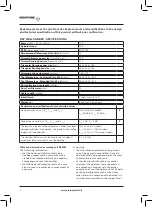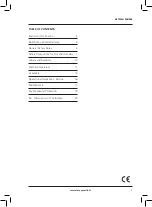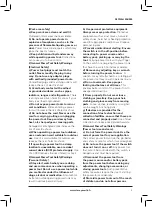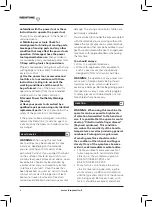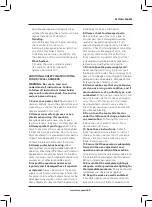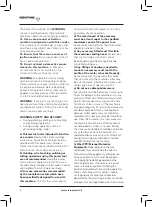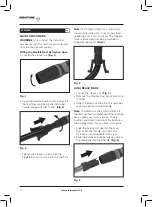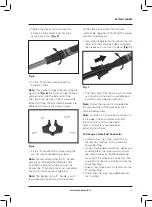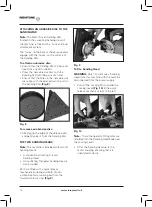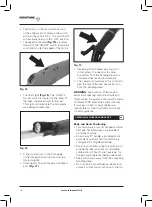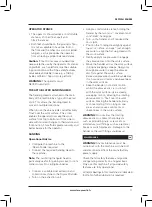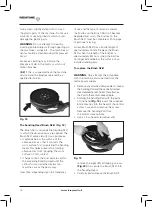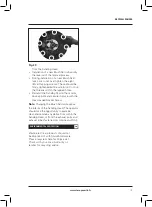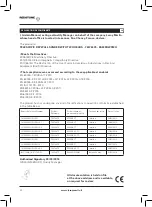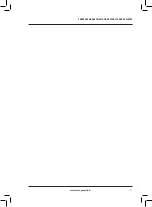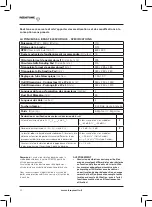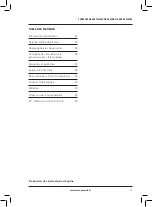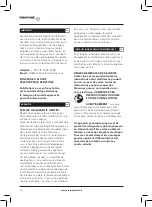
9
DRY WALL SANDER
www.leroymerlin.fr
can cause hearing loss, hearing protection (ear
defenders) should be worn during operations.
i) Keep people and bystanders at a safe
distance from the work area.
Anyone entering
the work area must wear the appropriate PPE.
Debris from the machining process, or from
a damaged accessory can fly considerable
distances, and could cause injury to people
beyond the immediate area of operation.
j) Hold the tool only by the insulated
gripping surfaces when performing an
operation in which the rotating accessory
may contact hidden wiring or the machines
own power cable.
Contact by the rotating
accessory with a ‘live’ wire can make ‘live’ any
exposed metal parts of the power tool, and
cause an electric shock to the operator.
k) Ensure that the power cable is routed well
away from the fitted spinning accessory.
If
you lose control, the power cable could be cut
by the spinning accessory. The cable could also
become tangled in the spinning accessory and
this could cause the hand or arm of the operator
to be pulled towards the accessory.
l) Never put the power tool down until
the motor is switched off and any fitted
accessory has come to a complete stop.
A spinning accessory may ‘grab’ any surface
it comes into contact with and could pull the
power tool from the operators grasp.
m) Do not use the edge or rim of a fitted
accessory for machining purposes.
Trying
to use the edge or rim of the spinning
accessory increases the risk of accidental
‘snagging’ of the operators clothing, and
the possibility of the operator being pulled
towards the spinning accessory.
n) Clean the ventilation holes of the
power tool regularly.
The motor fan may
draw dust into the motor housing. If the dust
contains metallic particles, any excessive
accumulation of powered metal could cause
an electrical hazard.
o) Do not operate the power tool near
flammable materials.
Sparks could ignite
these materials.
p) Do not use accessories that require
liquid coolants.
The use of water or other
coolants or lubricants may increase the risk to
the operator of electrocution or electric shock.
SAFETY INSTRUCTIONS FOR
OTHER OPERATIONS
Causes and operator prevention of kickback:
Kickback is a sudden reaction to a pinched,
bound or misaligned spinning accessory.
This may cause the accessory to lift up and
away from of the work area and be propelled
towards the operator:
• When the accessory is pinched or bound
tightly, the accessory may stall and the
motor torque reaction may drive the unit
rapidly back toward the operator;
• If the accessory becomes twisted or
misaligned it may ‘dig’ into the work
surface causing the accessory to climb
out of the work surface and jump back
towards the operator.
1. Hold the power tool firmly and position
your body and arms to allow you to resist
kickback forces. If necessary, to resist
reactive forces, use any auxiliary handles
provided to ensure maximum rebound
and/or torque control during start up. The
operator can control torque reactions or
kickback forces, if precautions are taken.
2. Never place your hands near the rotating
accessory. Your hand could come into
contact with the rotating accessory.
3. Ensure that you position yourself away
from the area that the power tool may
rebound towards if kickback occurs. Any
rebound usually pushes the power tool in the
opposite direction to the machining operation.
4. Take special care when working in corners
or along sharp edges etc. Avoid ‘bouncing’
or snagging the accessory. Corners, sharp
edges or bouncing have a tendency ‘grab
and trap’ a rotating accessory and this can
cause loss of control and kickback.
5. Do not attach a toothed saw blade, wood
carving blade or saw chain to this machine.
Such blades cause frequent kickback and
loss of control.
ADDITIONAL SAFETY INSTRUCTIONS
FOR SANDING
WARNING:
Do not use oversized sanding discs
in this machine. Use only the size of sanding


